While the Fitbit sense earned all the news back a few weeks ago for its pile of new health sensing features, the reality is that the company will probably sell more Fitbit Versa 3 units than Sense units. And the Fitbit Versa 3 is essentially a Fitbit Sense that’s $100 cheaper, minus a couple of features you probably won’t use very often after the novelty likely wears off (namely, ECG and EDA scans). After finishing my In-Depth Review of the Fitbit Sense, I switched it out for the Fitbit Versa 3. So I’ve got a pretty good feel for how they differ…and where they’re basically the same watch.
The Versa 3 adds built-in GPS compared to the previous Versa units, plus a handful of health tracking features/metrics (that are also now rolling out to previous versions), but the Versa 3 gains the polish of the latest version of FitbitOS. And probably more meaningful to some are the additional phone and text capabilities slated to come this winter, as well as Google Assistant integration later this year.
In this review I’ll dive through all the new features, what works well (and doesn’t), and help you decide whether or not this is the right unit for you. In the case of the Fitbit Versa 3, I went out and purchased it myself. So if you find this review useful, simply hit up some of the links at the end of the post. Or, consider becoming a DCR Supporter. With that – let’s cover all the newness.
WHAT’S NEW:
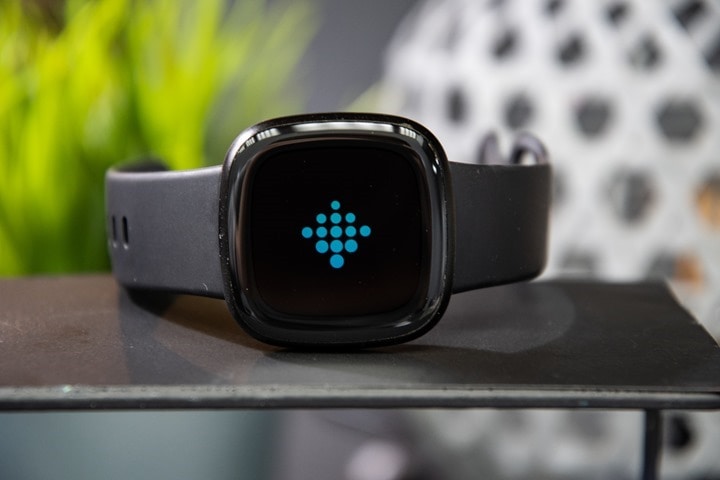
To consolidate all the marketing stuff down into actual new features, here are the differences between the Fitbit Versa 3 and the existing Versa 2. Keep in mind there are a handful of features like the SpO2 watch face that are also being concurrently rolled out to the Fitbit Versa 2. So while it was announced with the Versa 3, the Versa 2 gets access too now. Same goes for the breathing rate, HRV, RHR, and Skin Temp, Woot.
– Adds GPS internally
– Added Breathing Rate (per minute), while you sleep*
– Added Heart Rate Variability (HRV) Tracking*
– Added SpO2 Detailed Tracking with watch face (also now available to older units though)*
– Added new PurePulse 2.0 optical HR sensor (new sensor)
– Adding Google Assistant later this year (previously had Amazon Alexa, still does have that)
– Added ability to take calls from wrist using mic/speaker (planned Winter 2020-21)
– New AMOLED display with integrated ambient light sensor
– Display is Corning Gorilla Glass 3, and bezel is polished stainless steel
– Changed accessory bands to have better quick release system
*But wait, it’s a bit more complex than that. The Versa 2, Versa, Versa Lite, and Ionic with the Health Metrics dashboard for Premium users now (soon to all users), also have the following now:
– Breathing Rate
– Heart Rate Variability
– Resting Heart Rate
– Skin Temperature
– SpO2
In other words, all the new metrics are also now available on the existing Fitbit Versa/Ionic series watches for Premium users now and everyone else soon.
The differences between the Fitbit Versa 3 and Fitbit Sense are:
– Fitbit Sense adds ECG Functionality
– Fitbit Sense adds New Stress Management Tracking
– Fitbit Sense adds High/Low heart rate notifications
– Fitbit Sense adds EDA Scan app for tracking electrodermal activity
– Fitbit Sense has dedicated ski temp sensor (versus estimated temp in Versa 3)
– Fitbit Sense has minute by minute skin temp variations (Fitbit Versa 3 has less granularity, but still has skin temp variations)
– Also, the Fitbit Sense is a bit heavier due to the ECG & EDA sensors
Plus, things that were on recent Fitbit units are also here as well:
– Music storage built-in (Pandora & Deezer offline, Spotify is still phone control only)
– 24×7 HR Tracking, Steps, Sleep, Sleep Stages, and usual activity tracking
– Always-on Display Capable (but cuts into battery life claims)
– Supports Fitbit OS App Store
– Includes Active Zone Minutes (was rolled out last year in some devices)
– Water-resistant to 50 meters
– NFC Contactless Payments via Fitbit Pay
Also, for lack of anywhere else to mention it – note that the Versa 3 (like the Fitbit Sense) only permits the above music streaming services. You can no longer add your own music to the device (like MP3 files). In the case of Spotify, it’s only music control on your phone, not offline Spotify support on the watch.
As for battery life, the company claims 6 days of battery life with the non-always on screen setting selected. And, before we dive too far, here’s the full pricing list for the Fitbit lineup this year:

I’ll dive into the nuances of the Fitbit Sense vs Fitbit Versa 3 later on, though the TLDR version is just get the Versa 3 if you can’t decide. The ECG function launched today for the Fitbit Sense, though I suspect it isn’t likely something you’ll use often. And the EDA scans are at best questionable. And that’s basically it.
Now that the overview of new is done, we’ll start with the usual review bits and then dig deeper and deeper in each section.
IN THE BOX:
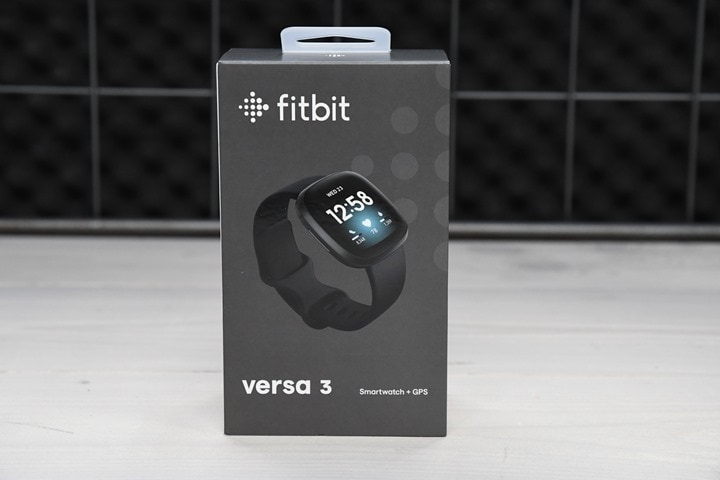
Here’s the Fitbit Versa 3 box, which, looks identical to the Fitbit Sense box except that it’s a different color. Still, I like it. It’s a clean and easy to understand box.
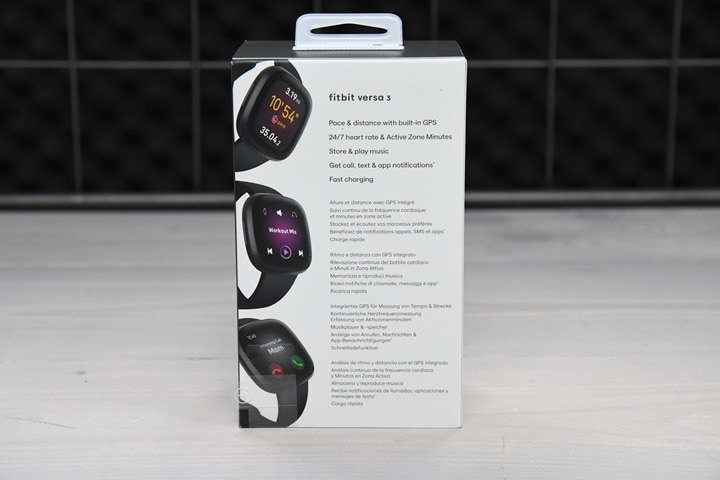
Inside, you’ll find both the small/medium and medium/large straps in the box (one is on the watch, the other is detached). So basically you get two straps to cover both sizings. I used the small/medium strap without any issues.
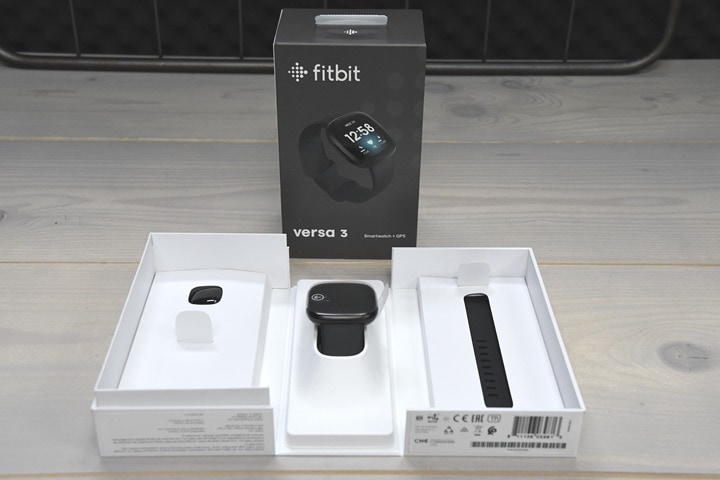
Take all the stuff out of the box and you’ll find the charging cable and quick-start manual floating around in there too:

Here’s a closer look at the charging cable, which is the same as on the Fitbit Sense. It’s a new cable for Fitbit though prior to this fall.
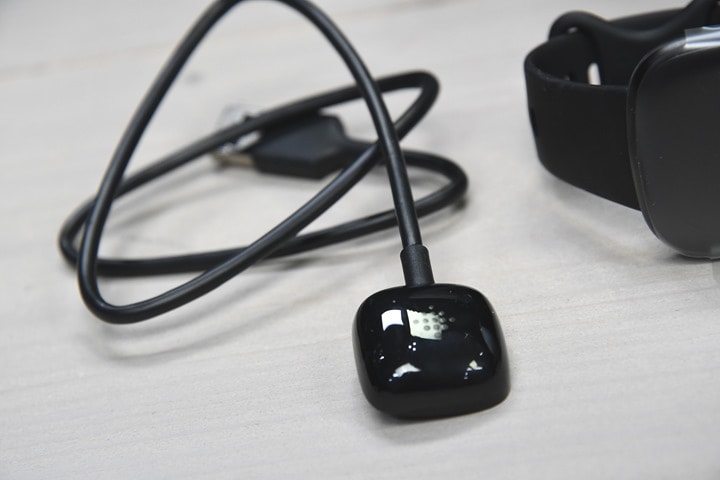
And here’s the extra longer strap:
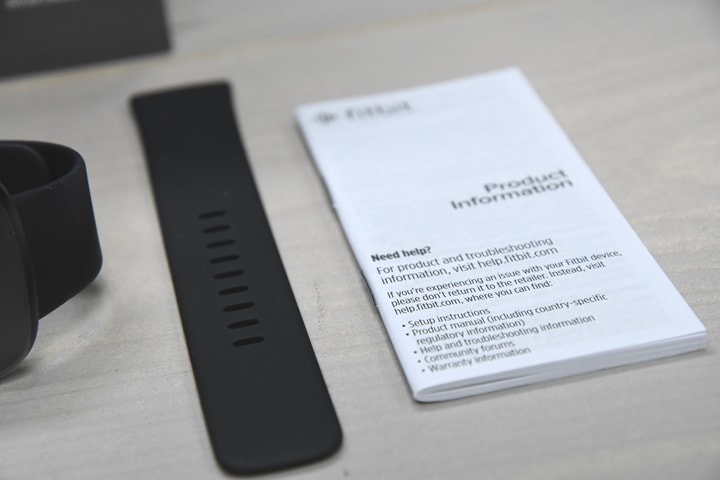
Here’s a quick look at the clasp as well as the back of the sensor:
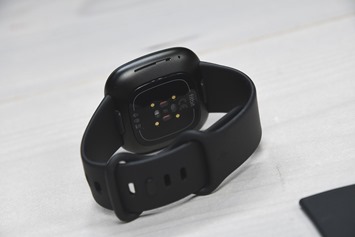
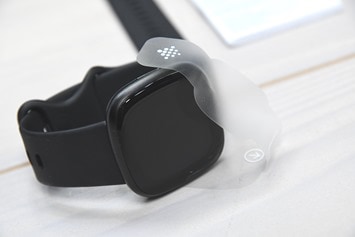
With that, let’s get it setup.
THE FITBIT BASICS:
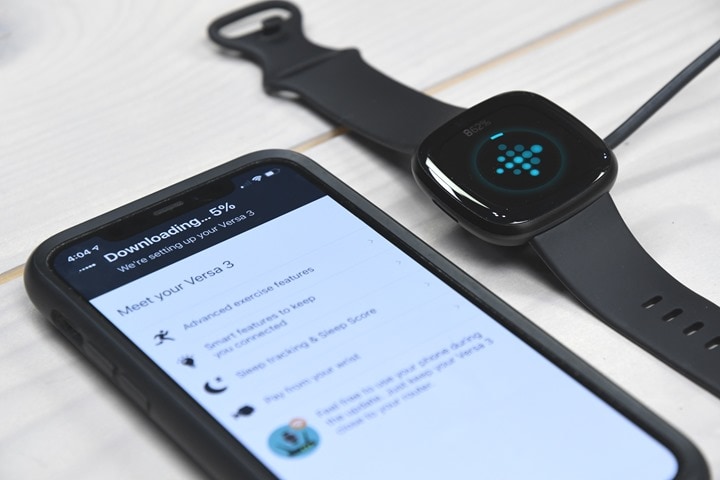
In most ways, the Fitbit Versa 3 hasn’t changed appreciably from the Versa 2 in areas like step counting, 24×7 activity tracking, and related aspects. Those all remain basically the same. Which, also remain basically the same as any other Fitbit in the last decade. What has changed here with the Fitbit Versa 3 (as well as the Fitbit Sense) is a slightly refreshed user interface.
Still, if you’re new to Fitbit in general, this section will probably be useful. Plus, while there are aspects of the Versa 3 I dislike, the Fitbit ecosystem is still far more complete from an activity tracking standpoint than Apple’s is, especially around reporting and social areas.
In any case, starting with the physical pieces, the watch maintains the semi-iconic Fitbit squircle shape (a square + circle). It’s identical to the Fitbit Sense in this regard – you’d almost never been able to tell them apart unless looking at the back of them. Sure, some people might think of it as Apple Watch-esque in terms of bezels and such, but I think for the most part it’s unique.
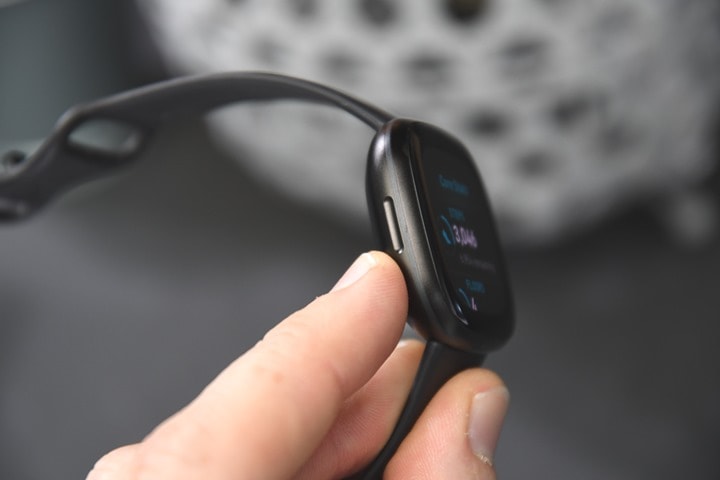
On the left side there’s a small indent, which is actually a hidden button. As I said in the Sense review, I’ve found this button largely awkward, namely because it’s on the underside/lower portion of the watch, so you have to reach under the lip of the watch to use it (preferably with your other index finger, but potentially your thumb works too).
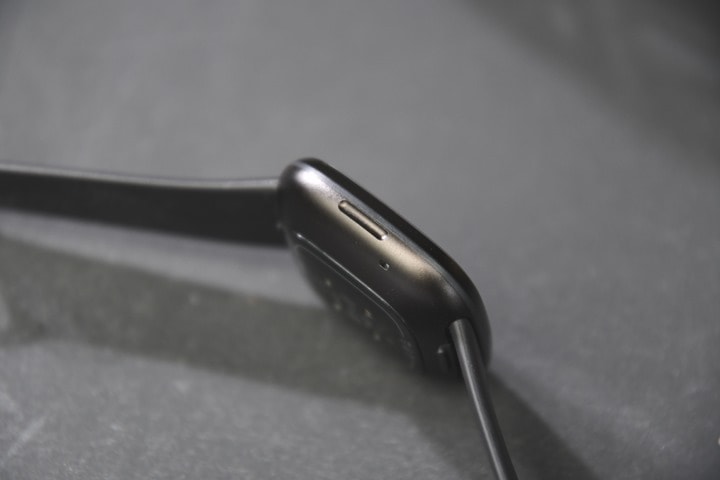
Some people got all upset about my comments about the horribleness that is the Fitbit Sense hidden button last time. Saying I was doing it wrong and such. And then people’s units arrived, and they all basically said some variant of the same thing: It’s not awesome.
And now 2-3 weeks-on using either the Sense or Versa 3 (with its hidden button), and my opinion is basically the same: It still sucks. Except, I simply subconsciously interact with the watch less, since I know most interactions with it usually result in some failed press/tap/swipe/touch. As it did with the Sense. Thus, here’s my bet for 2021: The button comes back.
I can virtually guarantee it will. Fitbit will put on a strong face now, but the feedback is overwhelmingly against it (I know, 12 people do apparently like it).
In any case, moving along. The stock band on the Fitbit Versa 3 is non-awesome. As I noted in the Sense review, it’s basically this half-Apple Watch sport style band, and half not. Which ends up just dragging the hairs on your wrist into the clasp and making a mess of things. The good news is you can spend money on other Fitbit bands to resolve that issue.
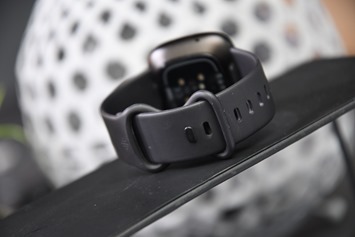
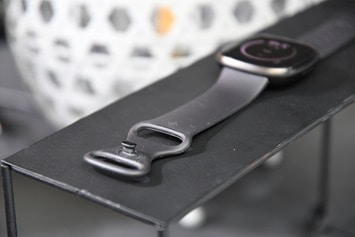
On the back is the new PurePulse 2.0 optical HR sensor, which is also identical to that on the Fitbit Sense.

The only differences though between the sensor suite on the Sense and the Versa 3 is that the Sense also has a skin temperature sensor nestled in there, as well as the ECG connectivity on the bottom (plus one on the watch face). But from a heart rate standpoint, it’s identical. At left below is the Versa 3, and at right is the Fitbit Sense.
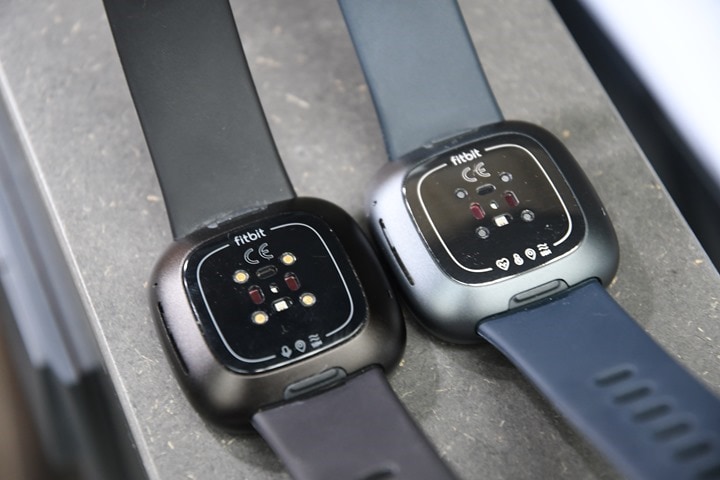
The Fitbit Versa 3 sees aspects of the user interface refreshed a bit, though, all of this is built atop FitbitOS. The changes aren’t major, but minor user interface updates that clean things up a bit – which look good. To begin, you can swipe-down to access smartphone notifications, or swipe from the left to access the control center:
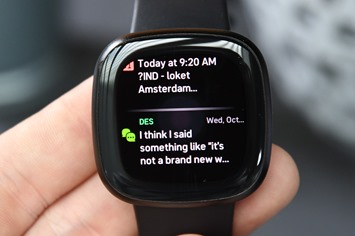
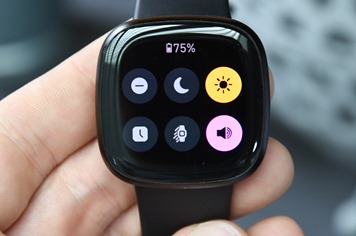
With the smartphone notifications you can’t respond when on iOS due to Apple limitations (though my understanding is on Android you can respond). But you can dismiss them. And then sometime this winter you’ll be able to answer calls on the Fitbit Versa 3 by using the microphone in the watch if your phone is within range. Note that there’s no cellular connectivity inside the Versa 3.
Next, you can customize watch faces within the Fitbit smartphone app. There are lots to choose from, both from Fitbit itself and 3rd parties. And once I no longer need the SpO2 watch face, I’ve definitely got my eye on that Moose Elk Large Fuzzy Animal one below. After all, Canadian Thanksgiving is coming up next week…
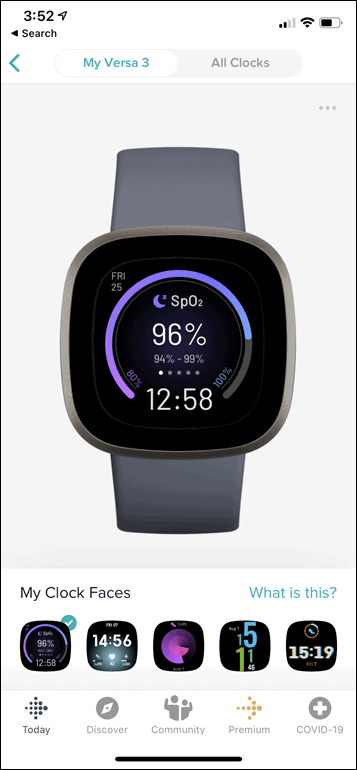
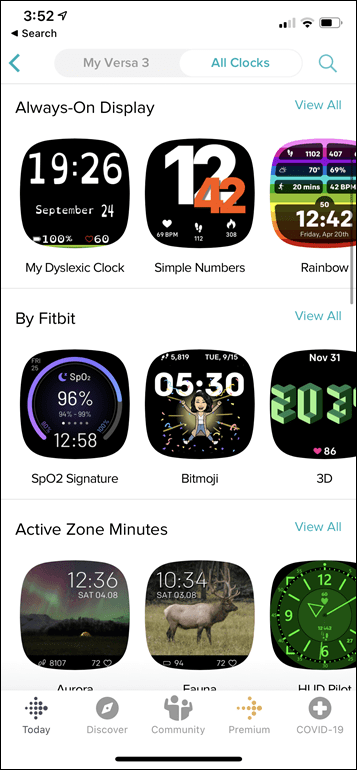
In my case, I was primarily using the Fitbit SpO2 watch face, since that’s what’s required to get SpO2 readings into the Fitbit Versa 3 at this time. Though, Fitbit says later this year that functionality will get rolled into the native watch firmware, so you can actually use whatever watch face you want.
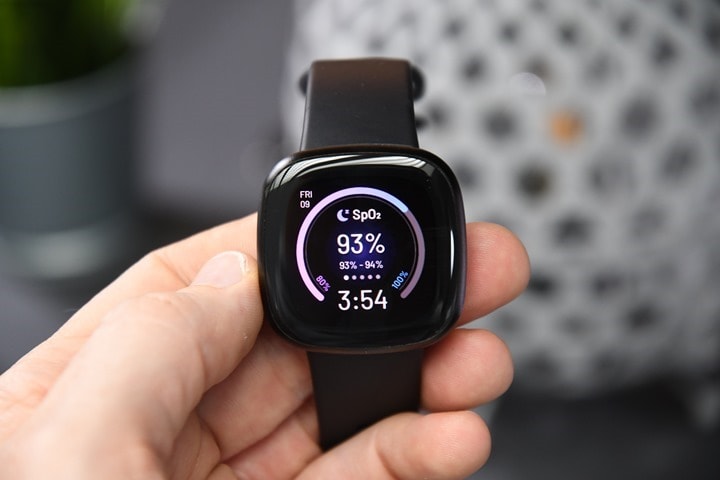
To access apps on the Versa 3 you’ll swipe from the right. Within a Fitbit smartwatch, everything is essentially an app. So for example, going and doing a workout means you open the Exercise app up. And it’s here that 3rd parties can also get into the game, such as a Starbucks app or such. There’s plenty of apps out there, but in general most of the apps on the Fitbit platform are pretty limited. That’s of course true on many wearable platforms, but I feel it’s especially true on Fitbit.
Being a Fitbit, the main thing you’re gonna want to do is track your daily activity. And the dashboard for doing that on a Fitbit is one of the best out there. There’s basically two ways you can access that. The first is by swiping upwards, which shows your core stats – things like steps/calories/distance/floors, and active zone minutes, as well as the progress towards your goals each day:
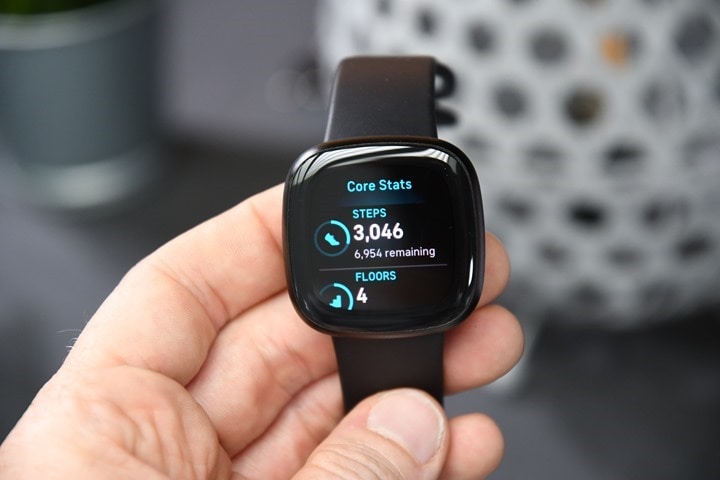
The goals can be defined within the Fitbit app for most of the core categories…..read more…………